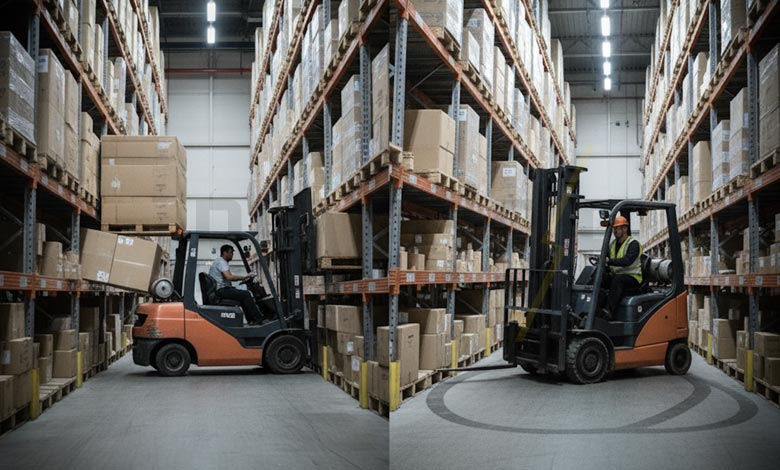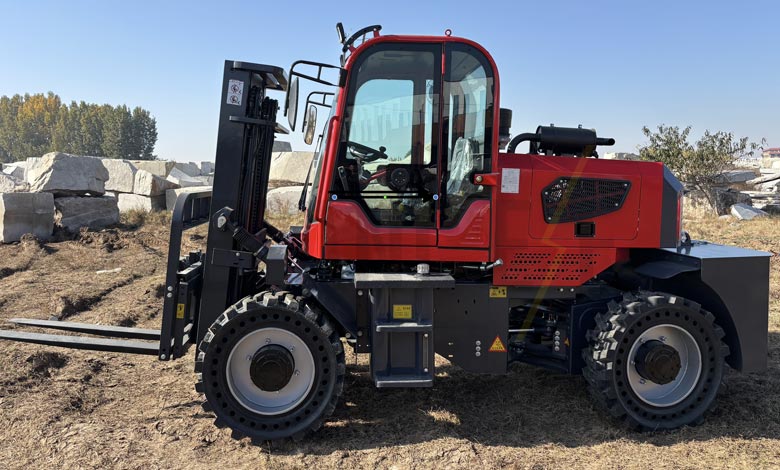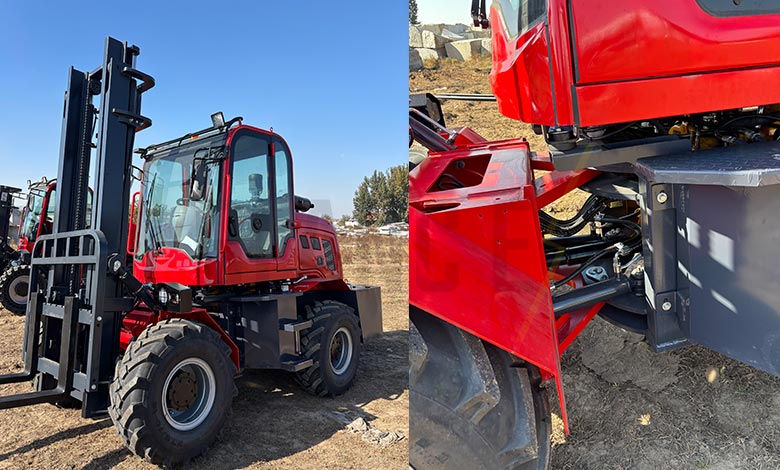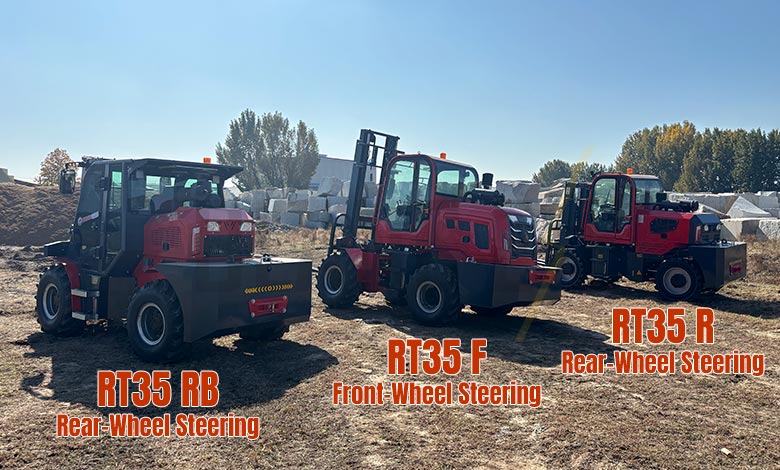Many buyers ask me the same question the first time they see a rough terrain forklift:
“Is this model front-wheel steering1 or rear-wheel steering — and which one is better?”
It sounds like a small detail, but the steering system determines much more than you think —
it affects safety, handling, operator control, and real-world efficiency.
In rough terrain or tight job sites, even a small difference in turning behavior can decide whether the job goes smoothly or not.

The Core Difference
The biggest distinction between front-wheel and rear-wheel steering lies in where the steering pivot is and how the vehicle moves around it.
Rear-wheel steering offers a smaller theoretical turning radius2 and performs best in open outdoor sites.
Front-wheel steering provides more intuitive control3 and higher safety in tight or low-clearance areas.
In short:
Rear-wheel steering turns sharper. Front-wheel steering drives smarter.

Rear-Wheel Steering: Classic Design, Tighter Geometry
Rear-wheel steering is the most common layout for forklifts.
The front axle stays fixed, while the rear axle pivots to turn the machine around its center point.
This gives it a smaller turning radius on paper — and faster maneuvering in wide-open areas.
Advantages
- Smaller theoretical turning radius (about 20% shorter than front-steering models)
- Simpler design, easier to maintain
- Stable at higher travel speeds and in long runs
Limitations
- Tail swing is large — risky in narrow spaces
- The operator’s front view doesn’t match rear-wheel movement
- Works best on flat or semi-flat ground
| Item | Rear-Wheel Steering | Typical Performance |
|---|---|---|
| Steering Pivot | Near rear axle | Rotates around vehicle center |
| Turning Radius | Smaller (≈3.6 m) | Geometrically superior |
| Handling Difficulty | Higher | Tail swing risk |
| Ideal Site | Open, outdoor areas | Construction sites, yards |

Front-Wheel Steering: Intuitive Control for Tight Spaces
Front-wheel steering forklifts steer from the front axle — just like a car.
The operator can see exactly where the wheels are turning, and the rear end follows a predictable path.
That makes it safer and easier to control in confined or height-limited areas.
Advantages
- Intuitive, car-like steering feel
- No tail swing — safer near walls or obstacles
- More stable when loaded (weight over steering axle)
- Ideal for low or narrow environments
Limitations
- Slightly larger turning radius (around 4.5 m)
- More complex design, higher cost
| Item | Front-Wheel Steering | Typical Performance |
|---|---|---|
| Steering Pivot | Front axle | Direct steering response |
| Turning Radius | Larger (≈4.5 m) | Slightly wider |
| Operator View | Direct and intuitive | See wheel path clearly |
| Ideal Site | Tight, low-clearance areas | Basements, factories, loading zones |

Why a Smaller Turning Radius Doesn’t Always Mean “More Practical”
This is the most common misconception.
A smaller turning radius doesn’t automatically make a forklift more flexible in real operations.
Real-world maneuverability depends on:
- Tail swing risk (how much the rear sweeps during a turn)
- Operator visibility and steering feedback
- Control precision and margin for error
Rear-wheel steering may turn tighter, but its rear end swings widely —
which can easily hit walls or obstacles in tight areas.
Front-wheel steering moves in a way that’s more predictable and visible to the operator,
so it’s easier and safer to control, even if the radius is technically larger.
| Comparison | Rear-Wheel Steering | Front-Wheel Steering |
|---|---|---|
| Theoretical Radius | ✅ Smaller | Slightly larger |
| Tail Swing | ❌ Large | ✅ Minimal |
| Operator Visibility | ❌ Opposite direction | ✅ Forward-aligned |
| Control Margin | Medium | High |
| Real Maneuverability | Better in open areas | Better in confined spaces |

Which Steering Type Fits Which Job Site?
| Application Scenario | Recommended Steering Type | Reason |
|---|---|---|
| Construction site / Open yard | ✅ Rear-Wheel Steering | Wider space, faster turnaround |
| Basement / Tunnel / Factory aisle | ✅ Front-Wheel Steering | Narrow or low-clearance work |
| Port / Logistics zone | ✅ Front-Wheel Steering | Frequent short movements |
| Quarry / Rough ground | ✅ Rear-Wheel Steering | Strong traction, open path |

The Next Step: Articulated + 4WD Forklifts4
Modern rough terrain forklifts are evolving toward articulated front steering5,
allowing them to nearly pivot in place while maintaining 4WD power6.
This hybrid setup combines both advantages —
the compact geometry of rear steering and the intuitive control of front steering.
The future trend is clear: “Articulated + 4WD + Low Center of Gravity”
will define the next generation of rough terrain forklifts for confined or complex sites7.

Conclusion
In the world of rough terrain forklifts:
- Rear-wheel steering represents traditional agility and efficiency.
- Front-wheel steering represents modern safety8 and intuitive control3.
The question isn’t which one is “better” —
it’s where you’re working.
If your site is wide and open, rear-wheel steering will move faster and turn tighter.
But if you’re working in basements, tunnels, or tight indoor passages,
a front-wheel steering1 4WD rough terrain forklift will help you handle every turn with precision and peace of mind.
Explore this resource to understand how front-wheel steering enhances safety and control in tight spaces, crucial for effective forklift operation. ↩
Explore how turning radius affects operational efficiency in various environments. ↩
Learn why intuitive control is crucial for operator safety and efficiency. ↩
Explore this link to understand how 4WD forklifts enhance performance in rough terrains, ensuring safety and efficiency. ↩
Explore how articulated steering can improve efficiency in confined spaces. ↩
Learn about the benefits of 4WD in challenging environments. ↩
Discover which forklifts are best suited for challenging work environments. ↩
Stay updated on safety innovations that can protect operators and equipment. ↩
